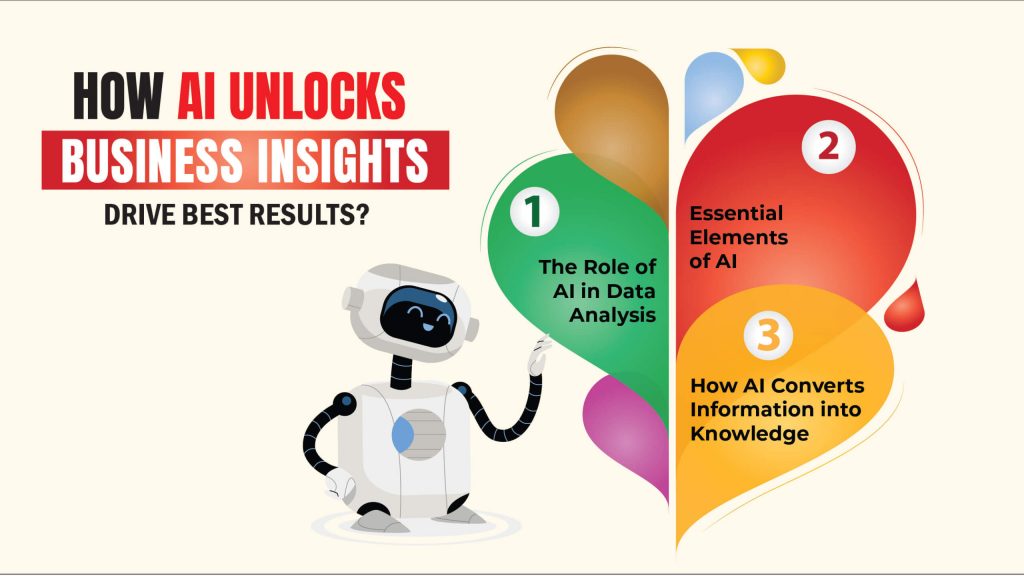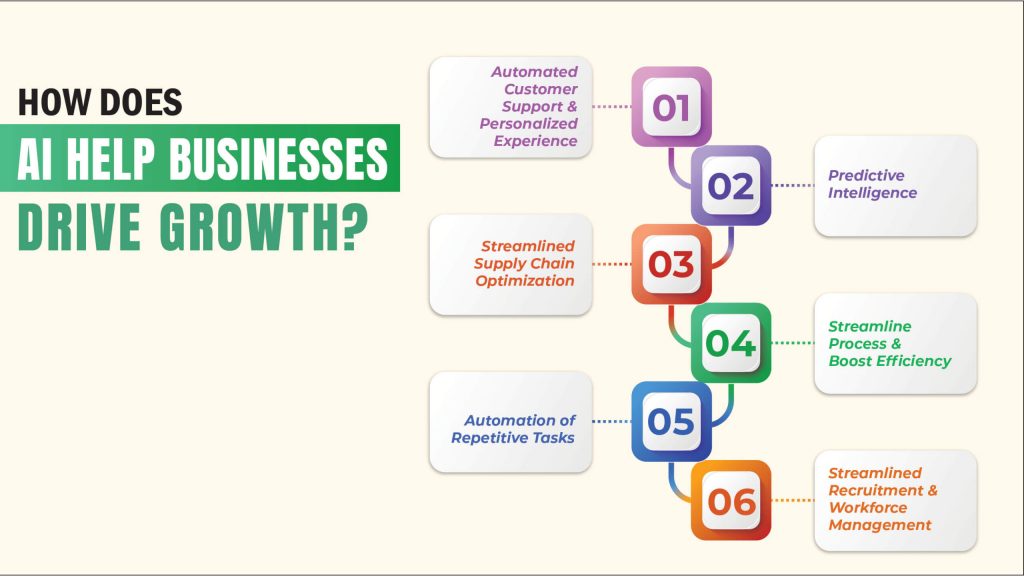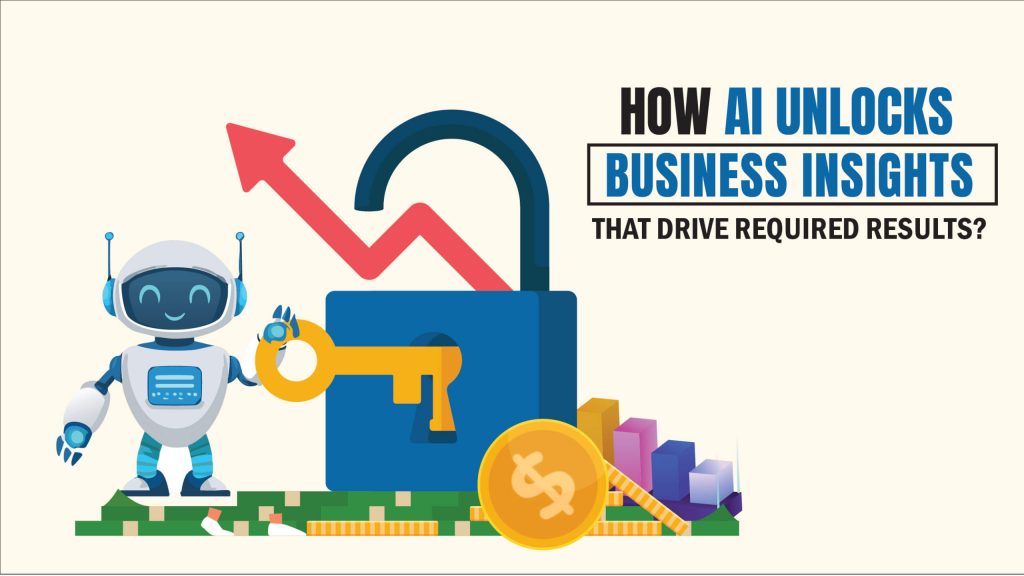Introduction
Thank you for reading this post, don't forget to subscribe!Most likely, you’ve heard all the buzz about artificial intelligence and how it’s changing the business landscape. AI has evolved beyond science fiction and into reality, with businesses leveraging its power in novel ways. The main goal of AI is to use data to find trends and insights that might be missed by people alone.
- What does that actually mean for your company, though?
- What important insights might it provide for your company?
- In what ways might it enhance the customer experience and open doors to faster growth?
AI can identify patterns in your data to improve important company operations and find new opportunities through machine learning and predictive analytics. This might include anticipating client loss, making product recommendations, tailoring interactions, optimizing processes, and more. The possibilities are limitless if you know how.
In this post, we’ll look at how AI-powered insights function and give instances of companies that have already implemented them. Even without a sizable data science team or tech budget, you’ll learn how to begin using AI in a way that will have a genuine impact on your business processes. The future is here, and it’s time to embrace intelligence. Let’s dive in and see how AI insights can open up new prospects!
Also Read: Leveraging AI to Collect Customer Insights In the Restaurant Industry
What Does Artificial Intelligence (AI) Mean for Businesses?
Artificial intelligence in business refers to applying AI technologies, such as computer vision, natural language processing, and machine learning, to improve business operations, increase worker productivity, and create value for the company.
Artificial intelligence affects a variety of business operations by simulating human intellect’s capacity for problem-solving and decision-making. AI systems enable a number of business automation techniques, such as enterprise and process automation, which serve to lower human error and free up human workers for more complex tasks.
In order to employ AI in an efficient business strategy, an organization must have a thorough understanding of its business operations, how AI operates, and which areas of the company can benefit from implementing it.
While automating tedious processes and boosting staff productivity are still common uses of AI tools, companies are now utilizing AI for more strategic, higher-level projects that contribute to greater corporate value.
It makes sense that 80% of businesses are spending money on AI to increase productivity and decision-making.
Also Read: How Business Intelligence is helping Businesses
How AI Unlocks Business Insights to Drive Best Results?

A. The Role of AI in Data Analysis!:
Data from a wide range of sources, including social media, customer interactions, sales data, industry trends, and more, is constantly flooding businesses. Nevertheless, decision-makers may become overwhelmed by this abundance of data, making it challenging to glean useful insights. Here’s where AI comes into play.
AI-powered solutions are able to handle enormous volumes of data at incredibly fast speeds, finding abnormalities, correlations, and patterns that might not be immediately apparent to the human eye. AI algorithms get more intelligent when they have the capacity to learn from data over time, producing predictions and suggestions that are more precise. This method enables firms to make more confident data-driven decisions, resulting in increased growth.
Also Read: Automating Data Analysis Using Artificial Intelligence
B. Essential Elements of AI:
- Machine Learning: Machine learning enables systems to learn from past data, forecasting consumer and market patterns to improve operational tactics.
- Natural Language Processing(NLP): NLP makes it possible for machines to comprehend and process human language, which makes it easier to analyze unstructured data—like customer reviews—and enhance engagement tactics.
- Predictive intelligence: Predictive analytics improves risk assessment, makes proactive business decisions that provide competitive advantage, and predictions outcomes using historical data and AI algorithms.
- Computer Vision: This technology interprets visual data, allowing businesses to study patterns such as consumer traffic, optimize layouts, and improve overall operations in order to increase sales and efficiency.
- Deep Learning: It uses neural networks to process enormous datasets, yielding insights that influence high-level strategic decisions.
Also Read: How Predictive Intelligence Transforms Retail
C. How AI Converts Information into Knowledge:
AI is revolutionizing the way businesses extract value from their data, allowing leaders like you to convert enormous and complex data into simple, actionable insights. AI identifies patterns, anticipates trends, and provides insights by analyzing structured, unstructured, and real-time data, allowing for faster decisions and more efficiency while creating a competitive advantage.
To properly understand this shift, examine the process depicted in the figure below—your road map to making better AI-driven decisions.
- Data Collection and Cleaning: AI-first collects data from a variety of sources, including sales platforms, social media, CRM systems, and Internet of Things devices. It cleanses the data by removing errors and extraneous information, allowing for high-quality data analysis.
- Pattern Recognition and Predictive Analytics: After the data is ready, AI finds correlations and patterns that the human eye might miss. Using machine learning algorithms, it may identify trends in past data and forecast future outcomes, such as customer behavior, market volatility, or supply chain requirements.
- Real-time Decision Support: Leaders can make prompt, data-driven decisions thanks to real-time insights provided by AI-powered tools. AI may, for instance, spot a sharp drop in consumer satisfaction or an increase in demand, enabling decision-makers to swiftly adjust their plans.
- Actionable Insights: In the end, AI turns data into insights that can be used to inform strategy rather than only presenting it. These findings might help in the refinement of marketing strategies, pricing optimization, consumer segmentation, and operational efficiencies. AI enables business executives to identify opportunities, mitigate risks, and act on data-driven information.
With this power, AI can help business executives make strategic decisions that have a significant impact rather than just being a tool for analysis. By using AI for business intelligence, organizations can automate intricate analysis, minimize human error, and concentrate on transforming insights into long-term competitive advantage.
“The ultimate aim of AI is not just automation but amplification—helping leaders make smarter, faster decisions.” – Satya Nadella.
Also Read: How Data Analytics Helps Restaurants Grow
How Does AI Help Businesses Drive Growth?

1. Automated Customer Support & Personalized Experience:
AI analyzes the vast amount of data business across various business touchpoints. The data covers past customers’ preferences, interactions, purchasing history, orders, etc. AI then collects, cleans, analyzes, and transforms crucial business insights that help businesses to personalize the customer experience.
This personalized experience improves customer experience which in turn boosts satisfaction, and loyalty and improves the bottom line.
With the help of personalized data, AI can even automate customer services and support. Based on the data collected and analyzed, AI can ensure 24/7 customer service and faster response times, which enhances the customer experience significantly. AI-powered chatbots assist customers solve simple problems and queries without requiring human support. This ability allows the human customer service workforce to focus on more complex problems.
Also Read: How AI Revolutionizes Customer Experience In Restaurant Industry
2. Predictive Intelligence:
Using previous data, AI algorithms may predict future patterns and behaviors. It enables companies to make more deliberate, proactive decisions rather than just responding to historical data. This competence enables business owners to make well-informed choices on market expansion, revenue forecasting, and inventory management. It’s about maintaining control, increasing productivity, and outperforming the competitors.
For example: A retailer having a supermarket selling all the essentials can collect all the required data such as market trends, popular products, and customer purchases, and use predictive analytics to forecast demand for the products. It helps businesses manage the inventory as per the customer demand in different months and seasons.
With this, they can have all the right stock in hand which ensures top-notch customer satisfaction and even reduces inventory wastage and saves other crucial business resources as well. In addition to reducing staff time, this guarantees timely and regular communication.
3. Streamlined Supply Chain Optimization:
AI helps companies optimize their supply chains from start to finish. It facilitates inventory control, demand forecasting, and logistics optimization. This results in cost savings, increased efficiency, and better customer service.
AI keeps track of what is in stock and what has to be ordered, which helps with inventory management. When supplies begin to run low, it has the ability to automatically place new orders. This minimizes waste and saves money by guaranteeing that the proper quantity of goods is always available.
Did you know, that Walmart decreased waste and increased consumer satisfaction by using AI to estimate demand and optimize inventory management, ensuring that products are available when and where they are required?
Logistics refers to the movement of products from one location to another. AI improves logistics by determining the most efficient routes for delivery trucks and the most effective methods for product packing and shipping. This makes deliveries faster and more efficient, which keeps customers satisfied.
Also Read: Benefit of Supply Chain Optimization for Businesses
4. Streamline Process & Boost Efficiency:
Businesses deal with so many diverse processes. Right from managing inventory and equipment to staff, logistics, customer support, etc. Any mistake in any process can ruin things for businesses. But AI steps in and helps businesses streamline end-to-end operations.
By evaluating workflow data, AI may uncover inefficiencies and recommend improvements to internal processes. By uncovering inefficiencies and streamlining operations, businesses can cut costs, and boost productivity.
For example, running a business with so many moving parts—inventory, logistics, staff, customer support—can feel a bit overwhelming for customers. A single slip-up in any process can lead to delays, unhappy customers, or extra costs. That’s when AI steps in. It works to analyze all the data and spot all the inefficiencies. For example, if certain products always run out of stock during peak sales, AI suggests better restocking schedules to keep shelves full.
With AI taking care of the heavy lifting, businesses can focus on growing while avoiding costly mistakes.
5. Automation of Repetitive Tasks:
There are many business tasks that are repetitive – that can take extensive manual hours and other crucial business resources as well – which can be automated so that businesses can invest in other important business tasks.
If you are looking to automate these repetitive tasks, then AI can help you out. With its amazing capabilities, it has proven to be an effective tool for automating laborious procedures that take too much time and are frequently subject to human mistakes.
- Data Handling: It handles data entry by processing invoices, updating records, and analyzing large datasets quickly and accurately.
- Customer Support: AI-powered chatbots answer routine questions and escalate complex issues to the right teams for seamless customer support.
- Inventory & Supply Chain Management: AI can help with inventory and supply chain management that predicts restocking needs, optimizes storage, and finds the best delivery routes to save money.
- Sales & Marketing: AI automates ad targeting, personalizes campaigns, and forecasts sales trends for marketing and sales.
- Recruitment & Hiring: AI can also automate recruitment by screening resumes, scheduling interviews, and helping onboard new employees with training tools.
- Finances: It simplifies financial operations like bookkeeping, tax calculations, and fraud detection while ensuring compliance through automated audits.
- Workflows: It improves workflows by automating approvals, task assignments, and project tracking for smooth and efficient operations.
Make sure to choose the right AI platform with relevant and best-in-class features as per your business to ensure desired automation.
Also Read: Benefits Of Supply Chain Optimization for Businesses
6. Streamlined Recruitment & Workforce Management:
Most businesses have a very extensive recruitment, onboarding, training, and workforce management – which takes a lot of time, money, and business resources. But, with AI – businesses can streamline recruitment and overall workforce management to much extent – saving crucial business resources.
Did you know, that AI reduces hiring times by a whopping 40% while improving candidate matching by 25%, according to LinkedIn’s Workplace Report?
Here’s what AI can do to redefine recruitment, onboarding and workforce management:
- AI-driven platforms can help businesses create job profiles on different hiring portals, generate job descriptions, screen resumes, and match candidates to job roles for seamless recruitment.
- After recruitment, AI can even streamline onboarding with structured SOPs and guide employees to get started.
- In addition, AI tools can even help with end-to-end workforce management by tracking employee performance, identifying skill gaps, and suggesting personalized training modules. This fosters employee growth while improving organizational efficiency.
Case Study: Unilever transformed its recruitment process with an AI tool – which helped them reduce the average hiring time from 4 months to 4 weeks and cut hiring costs by 50% while also improving the quality of hires.
Also Read: How Data Analytics Improve the Measurement of Employee Performance
1. Product Design and Development:
Product Design and Development is another time & resource-consuming task – which requires comprehensive research and creativity from professionals. The best AI tools can collaborate with owners or product managers to design relevant products that your customers will love.
According to Deloitte, AI reduces time-to-market for new products by 25–35%.
AI can help businesses collect past customer and current market data that they can leverage to curate products for their targeted market. With its predictive intelligence capabilities, AI can guide decision-makers in the right direction.
Did you know that the leading footwear and athleisure brand Nike uses AI to gather athlete performance data over time and design innovative footwear that their customers want, like their self-lacing sneakers? This targeted approach resulted in a 20% increase in product satisfaction among professional athletes.
2. Dynamic Pricing:
The world is moving fast, so should you. In this dynamic world, dynamic pricing is important as well. It helps companies stay competitive and maximize their revenue. As markets become more unpredictable, businesses need to adjust quickly to shifts in demand, supply, and market conditions.
Without dynamic pricing, companies risk losing out on opportunities to optimize their profits or might struggle to attract customers during slower periods.
AI-powered dynamic pricing takes this to the next level. It helps businesses by analyzing real-time data—such as customer behavior, competitor pricing, and even market patterns—to make instant price adjustments.
Moreover, AI enables personalized pricing by segmenting customers based on their preferences and behaviors. This helps businesses offer tailored prices, fostering customer loyalty and satisfaction.
Bonus: Get the Best AI Platform for your Business
Throughout the blog, we have mentioned the benefits and crucial use cases of leveraging AI to unlock crucial business insights and drive the best results.
But, it can only happen with the right AI tool that is compliant with your industry, business needs, and business goals. So, make sure to do your research, check out online reviews, get a free demo, and make the right decisions.
To make it a bit easier for you while you are looking for an AI platform – try out Livelytics. It is a one-of-a-kind AI data platform that is compliant for diverse industries with the best features such as data analysis, data transformation, real-time analytics, ad-hoc reporting, and data visualization with sophisticated technologies such as Business Intelligence, NLP, and Machine Learning.
Plus, it has two cost-effective pricing models that businesses can leverage without spending a fortune. To know more about how Livelytics can help, book a free demo right away.
To Wrap it Up!
Data has the edge among businesses. It helps businesses to stand out from the crowd and set their business for success. But, businesses deal with so much data on a daily basis that is scattered across different touchpoints – while AI has the power to collect data in one place, analyze it, transform it, and present it in front of decision-makers.
No hassles. No time-consumption. No resource consumption. Just relevant and targeted decisions. And, we hope our blog has answered the what, why, and how of AI for unlocking business insights.
Just make sure to choose the right tool, follow the best practices, and guide your team to get the most out of the AI tool for your business.
If you are looking for one, you can try out Livelytics. Book a free demo right away.
